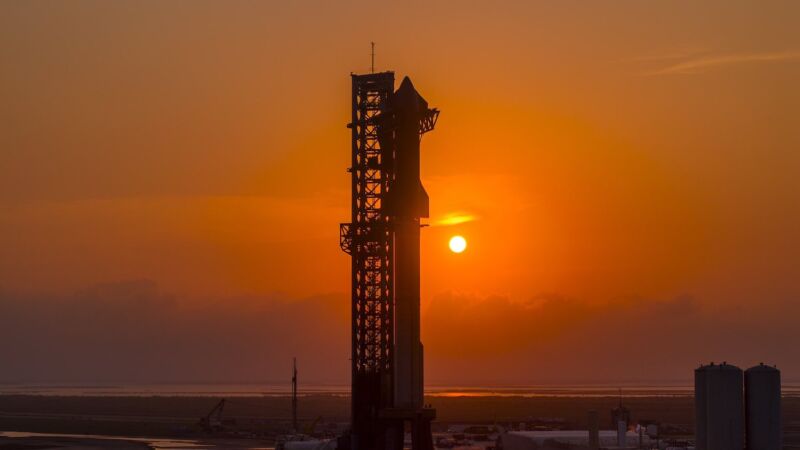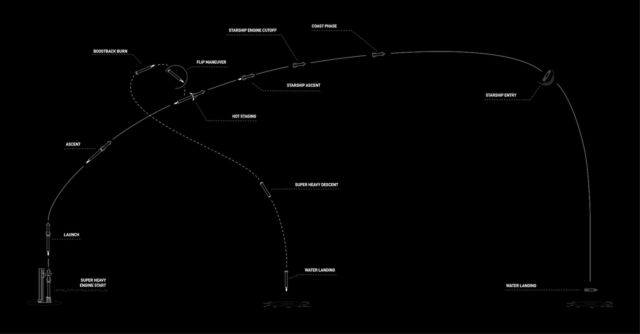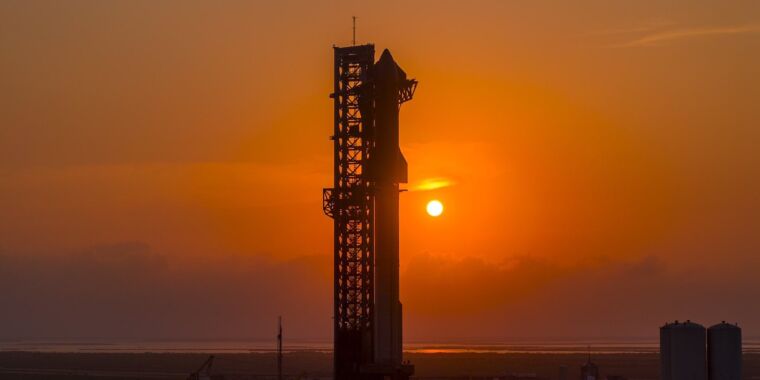SpaceX is about to launch Starship again—the FAA will be more forgiving this time

Enlarge / The rocket for SpaceX’s fourth full-scale Starship test flight awaits liftoff from Starbase, the company’s private launch base in South Texas.
SpaceX
The Federal Aviation Administration approved the commercial launch license for the fourth test flight of SpaceX’s Starship rocket Tuesday, with liftoff from South Texas targeted for just after sunrise Thursday.
“The FAA has approved a license authorization for SpaceX Starship Flight 4,” the agency said in a statement. “SpaceX met all safety and other licensing requirements for this test flight.”
Shortly after the FAA announced the launch license, SpaceX confirmed plans to launch the fourth test flight of the world’s largest rocket at 7: 00 am CDT (12: 00 UTC) Thursday. The launch window runs for two hours.
This flight follows three prior demonstration missions, each progressively more successful, of SpaceX’s privately developed mega-rocket. The last time Starship flew—on March 14—it completed an eight-and-a-half minute climb into space, but the ship was unable to maneuver itself as it coasted nearly 150 miles (250 km) above Earth. This controllability problem caused the rocket to break apart during reentry.
On Thursday’s flight, SpaceX officials will expect the ascent portion of the test flight to be similarly successful to the launch in March. The objectives this time will be to demonstrate Starship’s ability to survive the most extreme heating of reentry, when temperatures peak at 2,600° Fahrenheit (1,430° Celsius) as the vehicle plunges into the atmosphere at more than 20 times the speed of sound.
SpaceX officials also hope to see the Super Heavy booster guide itself toward a soft splashdown in the Gulf of Mexico just offshore from the company’s launch site, known as Starbase, in Cameron County, Texas.
“The fourth flight test turns our focus from achieving orbit to demonstrating the ability to return and reuse Starship and Super Heavy,” SpaceX wrote in an overview of the mission.
Last month, SpaceX completed a “wet dress rehearsal” at Starbase, where the launch team fully loaded the rocket with cryogenic methane and liquid oxygen propellants. Before the practice countdown, SpaceX test-fired the booster and ship at the launch site. More recently, technicians installed components of the rocket’s self-destruct system, which would activate to blow up the rocket if it flies off course.
Then, on Tuesday, SpaceX lowered the Starship upper stage from the top of the Super Heavy booster, presumably to perform final touch-ups to the ship’s heat shield, composed of 18,000 hexagonal ceramic tiles to protect its stainless-steel structure during reentry. Ground teams were expected to raise the ship, or upper stage, back on top of the booster sometime Wednesday, returning the rocket to its full height of 397 feet (121 meters) ahead of Thursday morning’s launch window.
The tick-tock of Starship’s fourth flight
If all goes according to plan, SpaceX’s launch team will start loading 10 million pounds of super-cold propellants into the rocket around 49 minutes before liftoff Thursday. The methane and liquid oxygen will first flow into the smaller tanks on the ship, then into the larger tanks on the booster.
The rocket should be fully loaded about three minutes prior to launch, and, following a sequence of automated checks, the computer controlling the countdown will give the command to light the booster’s 33 Raptor engines. Three seconds later, the rocket will begin its vertical climb off the launch mount, with its engines capable of producing more than 16 million pounds of thrust at full power.
Heading east from the Texas Gulf Coast, the rocket will exceed the speed of sound in about a minute, then begin shutting down its 33 main engines around 2 minutes and 41 seconds after liftoff. Then, just as the Super Heavy booster jettisons to begin a descent back to Earth, Starship’s six Raptor engines will ignite to continue pushing the upper portion of the rocket into space. Starship’s engines are expected to burn until T+ 8 minutes, 23 seconds, accelerating the rocket to near-orbital velocity with enough energy to fly an arcing trajectory halfway around the world to the Indian Ocean.
All of this will be similar to the events of the last Starship launch in March. What differs in the flight plan this time involves the attempts to steer the booster and ship back to Earth. This is important to lay the groundwork for future flights, when SpaceX wants to bring the Super Heavy booster—the size of the fuselage of a Boeing 747 jumbo jet—to a landing back at its launch pad. Eventually, SpaceX also intends to recover reusable Starships back at Starbase or other spaceports.

Enlarge / This infographic released by SpaceX shows the flight profile for SpaceX’s fourth Starship launch.
SpaceX
Based on the results of the March test flight, SpaceX still has a lot to prove in these areas. On that flight, the engines on the Super Heavy booster could not complete all the burns required to guide the rocket toward the splashdown zone in the Gulf of Mexico. The booster lost control as it plummeted toward the ocean.
Engineers traced the failure to blockage in a filter where liquid oxygen flows into the Raptor engines. Notably, a similar problem occurred on the second Starship test flight last November. The Super Heavy booster awaiting launch Thursday has additional hardware to improve propellant filtration capabilities, according to SpaceX. The company also implemented “operational changes” on the booster for the upcoming test flight, including to jettison the Super Heavy’s staging ring, which sits between the booster and ship during launch, to reduce the rocket’s mass during descent.
SpaceX has a lot of experience bringing back its fleet of Falcon 9 boosters. The company now boasts a streak of more than 240 successful rocket landings in a row, so it’s reasonable to expect SpaceX will overcome the challenge of recovering the larger Super Heavy booster.
SpaceX is about to launch Starship again—the FAA will be more forgiving this time Read More »
